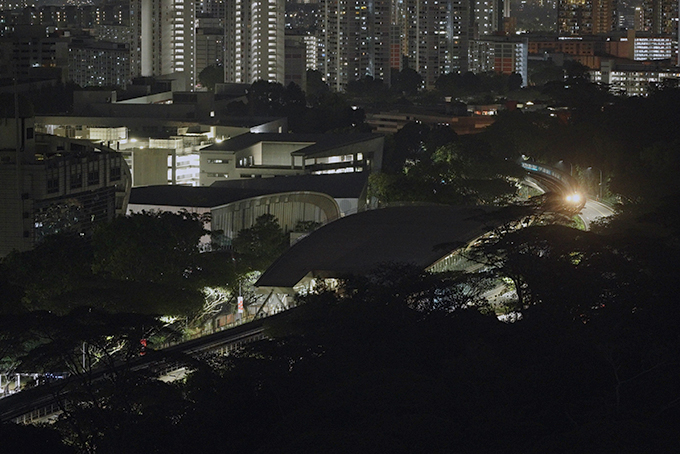How local documentary ‘While You Were Sleeping’ captures Singapore’s dramatic transformation over 20 years
9 June 2021
Vogue Singapore speaks to the duo behind the documentary to find out more about their creative process and the story they are trying to tell about Singapore
For the past year, it seems like almost everyone in Singapore has been hankering to go beyond the boundaries of our little red dot and throw ourselves into some exotic, far-flung spot. This heady wanderlust has only been exacerbated by our inability to do so thanks to pandemic-induced travel restrictions. Truly, nothing is quite as tantalising as forbidden fruit.

But it is a different story for Darren Soh, an architectural and landscape photographer who professes a “particular obsession” with vernacular architecture and nocturnal spaces. While the rest of us were daydreaming about holiday destinations overseas, Soh was steadily making his way around Singapore, turning his iPhone camera on the country’s unnoticed night landscapes. He has been doing this since 2003, producing two books and two exhibitions along the way. But Singapore now is very different from the place it was in the early naughts, and Soh found places he has previously photographed now irrevocably transformed.
This tension between the old and the new, the wild landscape and the built environment, shapes the basis of While You Were Sleeping, a documentary that Soh produced in collaboration with filmmaker Jeremy Ho. Narrated by Soh, the almost 18-minute film traces Singapore’s urban development through photographs shot by Soh over nearly two decades. Here, Vogue Singapore speaks to Soh and Ho about their documentary, their creative process, and the story they are trying to tell about Singapore.
On a Singapore in flux

Darren Soh (DS): I am on a mission to systematically document all the changes that have happened and are happening in Singapore’s built environment. So many of our country’s older buildings were demolished without ever being properly photographed. I hope my work fills this documentation void when it comes to the buildings we cannot save from destruction, and simultaneously advocate for the conservation of those that stand a chance of being preserved. It has also made me realise how precious unchanging places, such as nature reserves, are—they provide some comfort and anchor in a small island that is constantly being physically reinvented.
On Soh’s “obsession” with architecture

DS: I often joke that I prefer photographing buildings because they don’t talk back to me unlike people, but in fact, the buildings and landscapes that I photograph say so much about the human intention behind their existence. I find this oblique sort of “human study” far more fascinating than, say, photographing portraits. There is really nowhere you can go in Singapore where you will not feel or see the result of what humans have done to a space. The absence of overt human presence in my images would hopefully lead the viewer to look at the consequences of Man’s intervention rather than be “distracted” by the human figure.
On Soh’s “casual” iPhone photography style

DS: There is this adage that the best camera is the one you have with you at the point when you need to make a photo. It is impossible to carry a larger camera with me everywhere I go, and in many, many instances, I have managed to capture images that would have escaped me if I did not have my phone on hand. I have actually photographed commercial and editorial assignments using my iPhone since 2012, and have continued to do so till today. Now with the amazing Night mode on the iPhone 12 series, I am also able to literally see in the dark with my phone’s camera, allowing me to translate my vision for While You Were Sleeping into tangible images.
On storytelling with moving pictures versus with still photographs
DS: In many ways, filmmaking is an extension of photography. It covers so much more than a still image, but at the same time, it also isn’t able to convey things that a single shot of a scene frozen in time can. When I first started to produce documentaries, I struggled with translating what I wanted in my photographs to film. But over the years, I have come to accept that the two visual genres capitalise on different methods to tell stories to the viewer.

Jeremy Ho (JH): Given that this film is an extension of Darren’s voice, the key work I had to do was to shape his perspectives into a coherent narrative. We agreed it would not be a literal, journalistic grappling of issues, nor a how-to video, nor a retelling of Darren’s work. Instead, we wanted to create something atmospheric and almost poetic, that would draw on the formal approach of Darren’s photography to highlight the fundamental message we are trying to convey.
On the technical challenges of producing the documentary

JH: I did come up with an initial script as a guide of how we could sequence the story Darren was trying to tell. But after a while, it was like, “Screw it, let’s just see how the locations speak to us”. For the film’s visuals, I had a general shot list, but once I arrived on the scene, finding what to shoot became very instinctual. As the visuals came together, I also got a stronger sense of the atmosphere and tone of a particular space, so that made it easier to identify what are the important narrations to attach to a particular scene.
It was my first time shooting a film entirely at night, especially without production lighting sources. We planned our shoot nights based on moon phases. But to my surprise, I discovered Singapore actually has a lot of light at night. Our sky glows! Light pollution isn’t a nice thing, but it did work as ambient light for our film.




